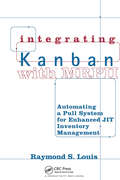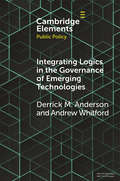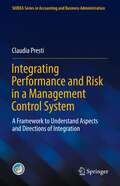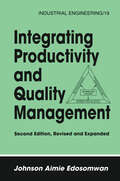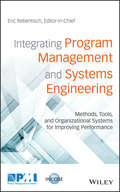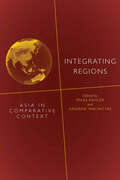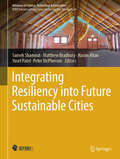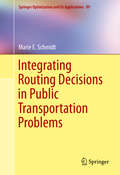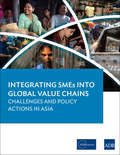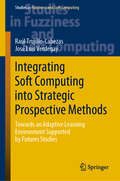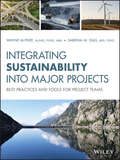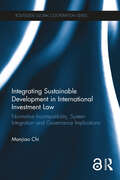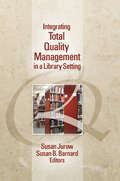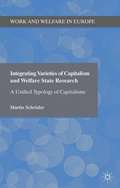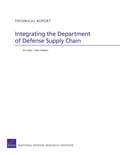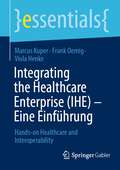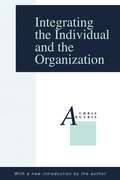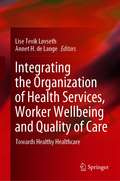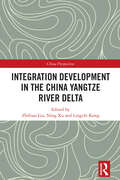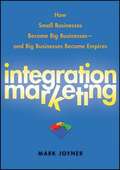- Table View
- List View
Integrating Kanban with MRP II: Automating a Pull System for Enhanced JIT Inventory Management
by Raymond S. LouisToyota Production System methods have rendered remarkable results in high-volume manufacturing plants, but they have not been fully understood and correctly applied in high-mix, low-volume environments. While lean principles do apply, the implementation methods and tools must be adapted and alternate methods embraced in a low-volume environment. This volume is specifically geared for manufacturers that have hundreds to thousands of active part numbers with few or no ongoing forecasted volumes, and for job shops that build only to order. The primary focus is eliminating non-value-added activities and instituting improvements on the most repetitive jobs, a strategy that gives you more time to produce your low-volume work or one-offs.About the author: Greg Lane is a faculty member of the Lean Enterprise Institute and an advisor to the Instituto de Lean Management in Spain. During his time with Toyota, he was one of ahandful of candidates selected for a one-year training program conducted by the company‘s masters. He became certified as a Toyota Production System (TPS) Key Person and continued his work with Toyota, training others in TPS. He has been highly active in working on implementing lean around the world, supporting large and small companies alike. In 1998, he began to focus his lean endeavors on meeting the specific needs of high-mix, low-volume enterprises. During his time as an independent consultant, Greg purchased and operated his own manufacturing company, which specialized in fast turnaround on high-mix, low-volume parts. Greg used TPS to grow the business and nearly double its sales. Greg and his associates have experience not only at adapting the methods contained in this book, but also in applying other tools that are too numerous to detail here. They can be reached for further support with your lean transformation via email: glane@lowvolumelean.com
Integrating Logics in the Governance of Emerging Technologies: The Case of Nanotechnology (Elements in Public Policy)
by Derrick Mason Anderson Andrew WhitfordThe governance of emerging technologies does not follow a single governance paradigm because of complex interactions between government, industry, and civil actors. In this Element, we will argue that for emerging technologies, governance is a 'convergent paradigm'. We introduce governance issues associated with emerging technologies generally before turning to the specifics of nanotechnology. We then approach governance theory and practice by considering different perspectives on governance by their different orientations with respect to object and process. Finally, we construct a matrix of object and process oriented governance activities observed in the case of nanotechnology in the United States.
Integrating Performance and Risk in a Management Control System: A Framework to Understand Aspects and Directions of Integration (SIDREA Series in Accounting and Business Administration)
by Claudia PrestiThis book presents a theoretical and empirical framework to interpret the possible configurations of the integration between performance management and risk management systems as part of management control systems. The book provides an overview of the development paths of these three systems, outlining the evolution and the current development of these disciplines, highlighting emerging issues and providing some original considerations. The author uses both an inductive and deductive approach in shaping the proposed framework, and includes the perspective of practitioners and academics on the topic. Based on a multiple case study in listed companies and a survey administered to small and medium enterprises, this book provides readers with valuable insights to adapt the proposed framework in different business contexts.
Integrating Productivity and Quality Management (Industrial Engineering: A Series of Reference Books and Textboo)
by Johnson EdosomwanThis second edition details all productivity and quality methodologies, principles and techniques, and demonstrates how they interact in the three phases of the productivity and quality management triangle (PQMT): measurement, control and evaluation; planning and analysis; and improvement and monitoring. This edition features material on practical
Integrating Program Management and Systems Engineering: Methods, Tools, and Organizational Systems for Improving Performance
by Eric RebentischIntegrate critical roles to improve overall performance in complex engineering projects Integrating Program Management and Systems Engineering shows how organizations can become more effective, more efficient, and more responsive, and enjoy better performance outcomes. The discussion begins with an overview of key concepts, and details the challenges faced by System Engineering and Program Management practitioners every day. The practical framework that follows describes how the roles can be integrated successfully to streamline project workflow, with a catalog of tools for assessing and deploying best practices. Case studies detail how real-world companies have successfully implemented the framework to improve cost, schedule, and technical performance, and coverage of risk management throughout helps you ensure the success of your organization's own integration strategy. Available course outlines and PowerPoint slides bring this book directly into the academic or corporate classroom, and the discussion's practical emphasis provides a direct path to implementation. The integration of management and technical work paves the way for smoother projects and more positive outcomes. This book describes the integrated goal, and provides a clear framework for successful transition. Overcome challenges and improve cost, schedule, and technical performance Assess current capabilities and build to the level your organization needs Manage risk throughout all stages of integration and performance improvement Deploy best practices for teams and systems using the most effective tools Complex engineering systems are prone to budget slips, scheduling errors, and a variety of challenges that affect the final outcome. These challenges are a sign of failure on the part of both management and technical, but can be overcome by integrating the roles into a cohesive unit focused on delivering a high-value product. Integrating Program Management with Systems Engineering provides a practical route to better performance for your organization as a whole.
Integrating Regions: Asia in Comparative Context
by Andrew Macintyre Miles KahlerThe proliferation of regional institutions and initiatives in Asia over the past decade is unmatched in any other region of the world. The authors in this collection explore the distinctive features of these institutions by comparing them for the first time to the experience of other regions; from the elaborate institution-building of Europe to the more modest regional projects of the Americas. It is an opportune moment for this reassessment, as the European regional model faces a sovereign debt crisis while Asian economies see more secure sources of growth from their immediate neighbors. Asias regional institutions display a distinctive combination of decision rules, commitment devices, and membership practices, shaped by underlying features of the region, the dynamics of regional integration, and the availability of institutional substitutes. Within this context, the authors propose changes that will better sustain the prosperity and peace that have marked Asia in recent decades.
Integrating Resiliency into Future Sustainable Cities (Advances in Science, Technology & Innovation)
by Matthew Bradbury Hasim Altan Sameh Shamout Yusef Patel Peter McPhersonExplore the forefront of urban resilience and sustainability with this groundbreaking collection of research and insights. From the 5th edition of the Resilient and Responsible Architecture and Urbanism (RRAU) conference, this book brings together diverse perspectives and innovative solutions for building resilient and sustainable cities of the future. Featuring contributions from leading scholars, practitioners, and policymakers, this book delves into the multifaceted dimensions of urban resilience at the city, community, and architectural scales. Discover case studies and research on smart urban furniture, medium-density urban planning, crime and urban resilience, green and cool roofs for extreme heat mitigation, and more. Dive into discussions on enhancing social resilience post-COVID-19, urban acupuncture theory for pandemic effects on public spaces, and street retrofitting interventions to boost community resilience. Explore resilient infrastructures, sustainable architectural design principles, and innovative approaches to construction waste management for a more sustainable future. This book serves as an invaluable resource for architects, urban planners, policymakers, researchers, and students interested in shaping the future of our cities. Whether you're seeking practical solutions or theoretical insights, "Integrating Resiliency into Future Sustainable Cities" offers a comprehensive overview of the latest advancements in resilient and sustainable urban development.
Integrating Routing Decisions in Public Transportation Problems
by Marie E. SchmidtThis book treats three planning problems arising in public railway transportation planning: line planning, timetabling, and delay management, with the objective to minimize passengers' travel time. While many optimization approaches simplify these problems by assuming that passengers' route choice is independent of the solution, this book focuses on models which take into account that passengers will adapt their travel route to the implemented planning solution. That is, a planning solution and passengers' routes are determined and evaluated simultaneously. This work is technically deep, with insightful finding regarding complexity and algorithmic approaches to public transportation problems with integrated passenger routing. It is intended for researchers in the fields of mathematics, computer science, or operations research, working in the field of public transportation from an optimization standpoint. It is also ideal for students who want to gain intuition and experience in doing complexity proofs and designing polynomial-time algorithms for network problems. The book models line planning, timetabling and delay management as combined design and routing problems on networks. In a complexity analysis, the border between NP-hard and polynomially solvable problems is illustrated. Based on that, the insights gained are used to develop solution approaches for the considered problems. Besides integer programming formulations, a heuristic method iterating planning and routing step is proposed to solve the problems.
Integrating SMEs into Global Value Chains: Challenges and Policy Actions in Asia
by Adbi AdbGlobalized production networks, or global value chains, provide an opportunity for SMEs to upscale their business models and to grow across borders. This process can enhance SME competitiveness, create more jobs, and promote inclusive growth in developing Asia. The Asian Development Bank (ADB) and the ADB Institute (ADBI) recognize the importance of integrating SMEs into global value chains. To provide pathways for such integration, this study examines ways of encouraging participation in value chains, and explores policy solutions to address the financial and nonfinancial barriers faced by these enterprises.
Integrating Safety and Security Management to Protect Chemical Industrial Areas from Domino Effects (Springer Series in Reliability Engineering)
by Ming Yang Genserik Reniers Chao ChenThis book provides insight into domino effects in industrial chemical sites and process industries. It is about the integration of safety and security resources to prevent and mitigate domino effects in the process industries. It explains how chemical industrial areas, comprised of various hazardous installations, are susceptible to a chain of undesired events, or domino effects, triggered by accidental events or intentional attacks and then presents solutions to prevent them. Firstly, the book provides a dynamic graph approach to model the domino effects induced by accidental fire or intentional fire, considering the spatial-temporal evolution of fires. Then, a dynamic risk assessment method based on a discrete dynamic event tree is proposed to assess the likelihood of VCEs and the vulnerability of installations, addressing the time dependencies in vapor cloud dispersion and the uncertainty of delayed ignitions. A dynamic methodology based on dynamic graphs and Monte Carlo is provided to assess the vulnerability of individuals and installations exposed to multi-hazards, such as fire, explosion and toxic release during escalation events. Based on these domino effect models, an economic approach is developed to integrate safe and security resources, obtaining the most cost–benefit protection strategy for preventing domino effects. Finally, a resilience-based approach is provided to find out the most cost-resilient way to protect chemical industrial areas, addressing possible domino effects. This integrated approach will be of interest to researchers, industrial engineers, chemical engineers and safety managers and will help professionals to new solutions in the area of safety and security.
Integrating Social Media into Information Systems: Requirements, Gaps, and Potential Solutions (G - Reference, Information and Interdisciplinary Subjects)
by Parisa Roshan Isaac R. Porche III Ryan Andrew Brown Astrid Stuth Cevallos Osonde A. Osoba Joshua Mendelsohn Douglas Douglas Yeung John Bordeaux Timothy R. Gulden Laura Kupe Luke J. Matthews Katharine Sieck Sarah SolimanThis report examines the technical challenges associated with incorporating bulk, automated analysis of social media information into procedures for vetting people seeking entry into the United States. The authors identify functional requirements and a framework for operational metrics for the proposed social media screening capabilities and provide recommendations on how to implement those capabilities.
Integrating Soft Computing into Strategic Prospective Methods: Towards an Adaptive Learning Environment Supported by Futures Studies (Studies in Fuzziness and Soft Computing #387)
by José Luis Verdegay Raúl Trujillo-CabezasThis book discusses how to build optimization tools able to generate better future studies. It aims at showing how these tools can be used to develop an adaptive learning environment that can be used for decision making in the presence of uncertainties. The book starts with existing fuzzy techniques and multicriteria decision making approaches and shows how to combine them in more effective tools to model future events and take therefore better decisions. The first part of the book is dedicated to the theories behind fuzzy optimization and fuzzy cognitive map, while the second part presents new approaches developed by the authors with their practical application to trend impact analysis, scenario planning and strategic formulation. The book is aimed at two groups of readers, interested in linking the future studies with artificial intelligence. The first group includes social scientists seeking for improved methods for strategic prospective. The second group includes computer scientists and engineers seeking for new applications and current developments of Soft Computing methods for forecasting in social science, but not limited to this.
Integrating Sustainability Into Major Projects: Best Practices and Tools for Project Teams
by Wayne McPhee Sabrina M. DiasA practitioner-focused guide featuring tools, models, and experience from the front lines of sustainability management on major projects With the growing need for sustainability management on large resource, infrastructure and power projects, this book provides project teams and sustainability practitioners with the practical advice, tools, and resources they need to create better projects. It offers extensive guidance for integrating sustainability into project design, planning and delivery. In each chapter, the authors provide invaluable sustainability management strategies and sample tools for project execution plans, engineering decision-making, stakeholder engagement tracking, logging commitments and follow-up actions, permit tracking, and construction management. Integrating Sustainability into Major Projects: Best Practices and Tools for Project Teams begins by introducing readers to the topic, as well as the common terminology. It then offers readers an overview of major projects, covering types of projects and project structures, the key players, and how to understand and manage different perspectives of time and space. Next, it looks at standards and guidelines, followed by chapters on: Project Management; Managing Risk and Opportunity; Sustainability Management Tools; Approvals and Permits; Design; Procurement; Construction Management; Commissioning; and more. This book: Provides analysis tools and resources that practitioners and project teams can use to successfully integrate and manage sustainability into major project design and delivery including industrial, resource, power, and infrastructure projects; Guides readers on how to work with local communities, engage with stakeholders and develop sustainability programs that support project financing; Includes case studies, lessons learned and expertise from a wide range of actual major projects and the authors' professional experiences with integrating sustainability; Leads practitioners through the major project types and their typical components, structure, and timelines, and demonstrates how sustainability can be effectively integrated into each type of major project. Integrating Sustainability into Major Projects provides the tools project teams need to successfully integrate sustainability into project design and management, making it an ideal tool for project teams and sustainability practitioners working on major resource, power, or infrastructure projects. It will also benefit project owners, organizational leaders, project finance professionals, government regulators and graduate students in engineering, project management, sustainability management, or environmental design and architecture.
Integrating Sustainable Development in International Investment Law: Normative Incompatibility, System Integration and Governance Implications (ISSN)
by Manjiao ChiThe current international investment law system is insufficiently compatible with sustainable development. To better address sustainable development concerns associated with transnational investment activities, international investment agreements should be made more compatible with sustainable development.Integrating Sustainable Development in International Investment Lawpresents an important systematic study of the issue of sustainable development in the international investment law system, using conceptual, normative and governance perspectives to explore the challenges and possible solutions for making international investment law more compatible with sustainable development. Chi suggests that to effectively address the sustainable development concerns associated with transnational investment activities, the international investment agreements system should be reformed. Such reform should feature redesigning the provisions of the agreements, improving the structure of international investment agreements, strengthening the function of soft law, engaging non-state actors and enhancing the dispute settlement mechanism.The book is primarily aimed at national and international treaty and policy-makers, lawyers and scholars. It is also suitable for graduate students studying international law and policy-making.The Open Access version of this book, available at http://www.taylorfrancis.com, has been made available under a Creative Commons Attribution-Non Commercial-No Derivatives (CC-BY) 4.0 license.
Integrating Sustainable Development in International Investment Law: Normative Incompatibility, System Integration and Governance Implications (Routledge Global Cooperation Series)
by Manjiao ChiThe current international investment law system is insufficiently compatible with sustainable development. To better address sustainable development concerns associated with transnational investment activities, international investment agreements should be made more compatible with sustainable development. Integrating Sustainable Development in International Investment Law presents an important systematic study of the issue of sustainable development in the international investment law system, using conceptual, normative and governance perspectives to explore the challenges and possible solutions for making international investment law more compatible with sustainable development. Chi suggests that to effectively address the sustainable development concerns associated with transnational investment activities, the international investment agreements system should be reformed. Such reform should feature redesigning the provisions of the agreements, improving the structure of international investment agreements, strengthening the function of soft law, engaging non-state actors and enhancing the dispute settlement mechanism. The book is primarily aimed at national and international treaty and policy-makers, lawyers and scholars. It is also suitable for graduate students studying international law and policy-making.
Integrating Total Quality Management in a Library Setting
by Susan Jurow Susan BarnardImprove the delivery of library services by implementing total quality management (TQM), a system of continuous improvement employing participative management and centered on the needs of customers. Although TQM was originally designed for and successfully applied in business and manufacturing settings, this groundbreaking volume introduces strategies for translating TQM principles from the profit-based manufacturing sector to the library setting. Integrating Total Quality Management in a Library Setting shows librarians how to improve library services by implementing strategies such as employee involvement and training, problem-solving teams, statistical methods, long-term goals and thinking, and an overall recognition that the system (not the staff) is responsible for most inefficiencies.Total Quality Management in a Library Setting describes the principles of TQM, its origins, and the potential benefits and barriers to be expected when adopting quality management approaches in libraries. Chapters provide guidelines for planning and implementation to help libraries use total quality management to break down interdepartmental barriers and work on continuously improving library services. The contributors, who have begun to think about using or who are already using TQM in a library setting, present specific planning and implementation issues that can be put to immediate use in libraries. With this innovative book, library managers will learn that by working together on problem solving teams to address specific operational questions, and by developing a shared knowledge of problem-solving tools and techniques, staff members grow personally and gain a larger sense of organizational purpose. Other TQM methods introduced in this book include the concept of the internal customer, which teaches staff to recognize how other staff members use the results of their work, and the principle of continuous improvement, which enables libraries to set measurable goals based on quantitative performance indicators, and to monitor progress toward those goals.
Integrating Varieties of Capitalism and Welfare State Research: A Unified Typology of Capitalisms (Work and Welfare in Europe)
by Martin SchröderThis book combines the two most important typologies of capitalist diversity; Esping-Andersen's welfare regime typology and Hall and Soskice's 'Varieties of Capitalism' typology, into a unified typology of capitalist diversity. The author shows empirically that certain welfare states bundle together with certain production systems.
Integrating the Department of Defense Supply Chain
by Eric Peltz Marc Robbins Geoffrey McgovernThe authors provide a framework for an integrated Department of Defense (DoD) supply chain, associated policy recommendations, and a companion framework for management practices that will drive people to take actions aligned with this integrated supply chain approach. Building on the framework and policy recommendations, they identify opportunities to improve DoD supply chain efficiency and highlight several already being pursued by DoD.
Integrating the Healthcare Enterprise: Hands-on Healthcare and Interoperability (essentials)
by Frank Oemig Viola Henke Marcus KuperDieses essential bietet einen Einstieg in das Thema IHE - "Integrating the Healthcare Enterprise (IHE)“ - und hilft sowohl Einsteiger:innen als auch fortgeschrittenen "Interoperabilitätsförder:innen" dabei, zu verstehen, wie IT-Systeme in Gesundheitsunternehmen die richtigen Daten, zum richtigen Zeitpunkt sicher miteinander austauschen können und wie es IHE schafft dafür Lösungen in den verschiedenen medizinischen Domänen anzubieten.
Integrating the Individual and the Organization
by Chris ArgyrisThe emphasis on organizational change in the corporate life of recent years-including job redesign, autonomous groups, high performance work systems, and the redesign of control systems-owes a great deal to the pioneering work of Chris Argyris. This book examines how individuals in organizations can become more effective, in turn making organizations more effective. It explores the conventional pyramidal structure of organizations, in which there is top-down control by managers over workers, and examines their negative consequences. These include organizational injustice and eventually irrational decision-making. Argyris also discusses the characteristic learning system of the modern organization, which he describes as -single-loop- in character. This system, he argues, is only adequeate enough to permit the organization to implement existing policies. It does not permit the more difficult and comprehensive task of questioning underlying goals and assumptions, which he terms -doubt loop- learning. In this kind of learning, the organization is able to confront the more difficult problems that affect organizations in a time of transition. In his new introduction, Argyris reviews the strengths and limitations of the argument advanced in Integrating the Individual and the Organization. He describes why the pyramidal structure endures, and why creating a self-learning organization is an even more challenging task than he has imagined. The book will be of interest to professionals with a long-standing interest in organizational development as well as those just entering the field, managers confronting the challenge of organization change, and researchers in organizational behavior and theory.
Integrating the Organization of Health Services, Worker Wellbeing and Quality of Care: Towards Healthy Healthcare
by Lise Tevik Løvseth Annet H. de LangeThis book introduces the concept of ‘healthy healthcare’ and posits that this new concept is necessary in light of a shortage of healthcare staff in the near future. Healthy healthcare implies that healthcare systems are designed, managed and financed in balance with the available resources to improve workers’ health and performance. Ultimately, a balanced perspective taking into account the patient, the staff and the complex healthcare system will lead to a more resource-efficient delivery of high-quality healthcare services.The book synthesizes evidence-based practice and research on the links between healthcare services, employee health and wellbeing, and quality of healthcare from an interdisciplinary perspective. Written by leading experts in this rapidly expanding field of inquiry, this is the first book ever compiled on the subject with such scope and breadth. It discusses how to conduct interventions and research on healthy healthcare with different populations and settings. The chapters critically examine the links between these pillars; and identify research gaps in both methodology and content from the perspectives of psychology, medicine, nursing, economy, law, technology, management and more. This innovative book is of interest to researchers and students of health sciences, public health, health economics and allied disciplines, as well as to stakeholders in the healthcare industry.Chapter 24 of this book is available open access under a CC-By NC-ND 4.0 license at link.springer.com
Integration Development in the China Yangtze River Delta (China Perspectives)
by Zhibiao Liu Ning Xu Lingchi KongThis book systematically investigates the strategic significance and dynamic mechanisms present in the development of the Yangtze River Delta cluster, one of the major drivers of economic growth in China.The Yangtze River Delta is the most densely populated region in China, with the highest level of economic development. Against the background of China’s national strategy that aims to bolster and augment integrated development on the regional level, this study reviews the development process of the region and possible hindrances to further growth. From a wide array of dimensions, it assesses the key influencing factors, including institutional construction, governance mechanisms, spatial layout, government and corporate competition, the market environment, industrial linkages and synergies, collaborative innovation, public service, and social networks. Based on theoretical analysis and empirical studies, the book advances policy suggestions that help to solve the challenges for integrated development in the region.The volume will benefit scholars and students, as well as investors, business observers, and policy makers interested in the Chinese economy, regional economics, industrial economics, and economic geography.
Integration Marketing
by Mark JoynerPRAISE FOR Integration Marketing "The most important book of the year. " -Codrut Turcanu, founder of Remarkable Blogging, www. RemarkableBlogging. com "Mark Joyner's new book rocks! After reading it yesterday evening, I put all other work on hold to create two integration marketing processes-and have been spreading the word about them. Already, within twenty-four hours, I've started seeing results. And the way I've implemented it is rudimentary and basic. There are so many nuances to make it more powerful and effective. To think so much wisdom and insight can be packed into such a short volume . . . wow! I'm urging everyone I care about in a business sense to stop everything else and read Integration Marketing right now. " -Dr. Mani Sivasubramanian, www. DrMani. name "I've read the book four times in one day. I gave my first lecture on Integration Marketing to my staff today-it generated incredible excitement. " -Alan Walker, CEO, Knowledgism, www. knowledgism. com "[Joyner deserves] a standing ovation for explaining so concisely how McDonald's and Microsoft are able to dominate their markets. " -Ian Del Carmen, President and CEO, Fireball Planet Corporation, www. FireballPlanet. com "My company generated an additional $20,368 in revenue last month as a direct result of Joyner's integration marketing concepts. " -Frank Bauer, founder, Add2It, www. add2it. com "I bought a $750,000 house in cash last year-pretty much because of the Integration Marketing strategies Mark taught us. It's now the major driving force of the growth of our company. " -Tellman Knudson, CEO, Overcome Everything, Inc. , www. OvercomeEverything. com "I must say . . . it's the most important book I've ever read. It's beyond the level of any other marketing strategy. " -Jason Mangrum, author of The Official Internet Business Q&A Report
Integration Through Law: ASEAN Economic Cooperation and Integration
by Chia, Siow Yue and Plummer, Michael G. Siow Yue Chia Michael G. PlummerASEAN economic cooperation and integration have come a long way since the organisation's early days, when cooperation was more political and diplomatic than economic in nature. ASEAN now constitutes the most ambitious organisation of regional cooperation and integration in the developing world. This book investigates the economics of various ASEAN and ASEAN-centric economic integration initiatives, focusing in particular on the ASEAN Economic Community (AEC). In addition to assessing the potential effects of the AEC on the economies of the ten ASEAN member states via changes in trade, foreign direct investment and economic structure, this book underscores the implementation challenges ASEAN faces as it completes the AEC project. It also considers the AEC in the context of the Regional Comprehensive Economic Partnership (RCEP). This comprehensive study is written for academic researchers and students, as well as for policy makers in ASEAN as they chart the future policy path of the region.
Integration Through Law: ASEAN as an Actor in International Fora
by Jürgen Rüland Nguitragool, Paruedee and Rüland, Jürgen Paruedee NguitragoolASEAN as an Actor in International Fora addresses a blind spot in ASEAN research and in comparative regionalism studies by assessing why, how, when and to what extent ASEAN member governments achieve a collective presence in global fora. Written for academic researchers and practitioners working in areas such as international relations, political science and international law, it examines ASEAN's negotiating behavior with a novel four-point cohesion typology. The authors argue that ASEAN's 'cognitive prior' and its repository of cooperation norms have affected ASEAN's negotiation capacities, formats, strategies and cohesion in international fora. Using two case studies - one on ASEAN's cohesion in the WTO agricultural negotiations and one on UN negotiations on forced labor in Myanmar - they examine ASEAN's collective actions at different stages of negotiation, in different issue areas and in different negotiating fora. The book concludes by providing recommendations for strengthening ASEAN's international negotiation capacities.
